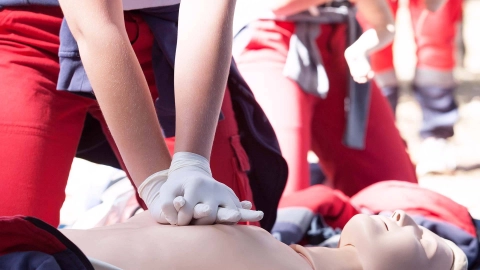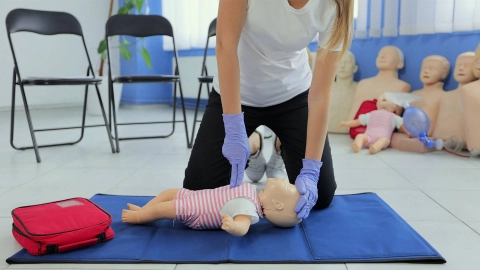Health care Home medicine cabinets: medication, medical dressings and more
A well-stocked home medicine cabinet helps deal with minor injuries and alleviate mild ailments. In addition to frequently required medication, a home medicine cabinet should also contain medical dressings and various medical aids such as a thermometer.
At a glance
- A home medicine cabinet should contain a range of frequently required medication, medical dressings and medical aids.
- When stocking a home medicine cabinet it is important to consider everyone who lives in the household.
- Children sometimes require special, age-appropriate medication.
- A home medicine cabinet should be positioned in a fixed, cool, dry, dark place that is easily accessible but out of the reach of children.

What is a home medicine cabinet?
Whether cuts and grazes, mild pain, a high temperature or a common cold, a well-stocked home medicine cabinet helps alleviate symptoms in the event of mild illnesses and deal with minor injuries.
A home medicine cabinet should contain a range of frequently required medicinal products (medication) and medical dressings. Medical aids such as a thermometer, cooling pads or a hot water bottle are also useful.
When stocking a home medicine cabinet it is important to consider everyone who lives in the household. In particular, children require special, age-appropriate medication. It is also important to consider the health of all household members and any allergies or chronic illnesses that they may have, such as asthma.
What medication should a home medicine cabinet contain?
A home medicine cabinet should ideally contain medication that is suitable for all household members. In this regard, it is important to note that children usually need medication that differs from or has a weaker dosage than that used by adults.
The basic items in a home medicine cabinet include:
- personal medication that is regularly required, e.g. for asthma or allergies
- cold remedies for combating coughs, sneezing and sore throats
- painkillers and fever-reducing medication (antipyretics) such as ibuprofen or paracetamol
- products for combating diarrhea, vomiting and nausea
- electrolytes for rectifying fluid loss, for example following severe diarrhea
- products for sunburn and insect bites (antihistamine gel)
- anti-inflammatory and cooling gel for minor sports injuries
- burn, wound and healing ointment
- decongestant nasal drops or nasal spray – however, these should only be used temporarily for a few days
- oral herpes (cold sore) ointment, if a household member is prone to this
- heartburn tablets, if a household member is frequently affected by this
Herbal teas can also alleviate minor ailments. Useful additions to your home medicine cabinet can include:
- aniseed, fennel and caraway tea for digestive issues
- chamomile tea for stomach ache
- sage tea for common colds and flu infections
What medical dressings should a home medicine cabinet contain?
The following products and materials are useful for quickly dealing with minor injuries such as cuts and grazes:
- Plasters in various sizes
- Bandages and gauze swabs
- Bandage scissors
- Triangular bandage for securing compresses, for compression bandages or for supporting limbs
- Tweezers for removing splinters
- Wound disinfectant
- Skin disinfectant
- Disposable gloves
What medical aids should a home medicine cabinet contain?
In addition to medication and bandages, there are a few medical aids that every well-stocked home medicine cabinet should contain or that should be easily accessible elsewhere in the household:
- thermometer
- hot water bottle
- cooling pad, stored in the fridge
- tick removal tweezers or card
- torch for checking the pupils, for example following head injuries or in the event of suspected concussion
- linen cloth for use as a moist compress
The home medicine cabinet should contain the following information to enable a quick response in an emergency:
- Instructions on how to perform first-aid measures on adults and children
- List of emergency numbers, for example for the emergency services, medical assistance service and poison control center
What should a home medicine cabinet contain for children?
Many medicinal products for adults are unsuitable for children, even in a lower dose. Children should therefore be considered when stocking the home medicine cabinet. Alternatively, you can create a designated children’s home medicine cabinet. This should contain the following:
- antipyretic (fever-reducing) and painkilling suppositories or suspensions
- wound and healing ointment suitable for children
- zinc ointment for combating diaper rash for children who wear diapers
- decongestant nasal drops or saline drops for temporary use
- antihistamine gel for sunburn and insect bites
- anti-foaming agents such as dimethicone, which can be used as a first-aid measure after foaming cleaning or washing agents are swallowed and to prevent bloating
Important: When stocking a children’s home medicine cabinet, you can obtain advice from a pediatrician or pharmacist.
Where should a home medicine cabinet be stored?
The home medicine cabinet should have a fixed place in the household so there is no need to search for it in the event of acute illnesses, following accidents or in emergencies. Even if they appear practical choices, the kitchen and bathroom are unsuitable locations as many medicinal products are sensitive to heat, moisture and light.
The home medicine cabinet should ideally be a lockable cupboard in a cool, dry place. It should be easily accessible to adults but out of the reach of children.
It is also important to regularly check if the contents of the home medicine cabinet are still in date. The use by date is shown on packaging. Expired or spoiled medication can usually be disposed of with the household waste, but not down the drain or toilet.
Important: Medication should ideally always be stored in its original packaging with the package insert. This provides you with easy access to all important information.
- Berufsverband der Kinder- und Jugendärzte e.V. kinderarzte-im-netz.de. Hausapotheke. Aufgerufen am 04.10.2022.
- Bundeszentrale für gesundheitliche Aufklärung (BzgA). kindergesundheit-info.de. Die Kinder-Hausapotheke. Aufgerufen am 04.10.2022.
- Gelbe Liste. Dimeticon. Aufgerufen am 04.10.2022.
- Unabhängige Patientenberatung Deutschland (UPD). Hausapotheke. Aufgerufen am 04.10.20220.
In cooperation with the Federal Institute for Drugs and Medical Devices (BfArM).
As at:





